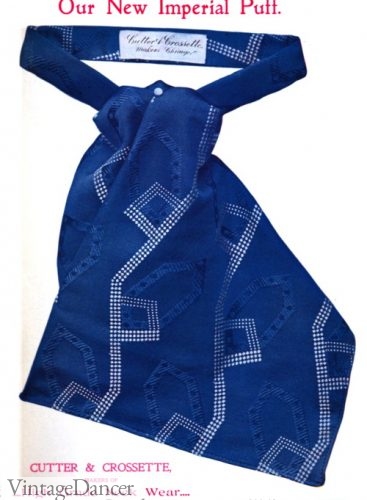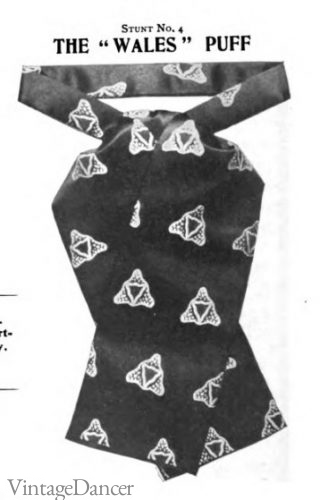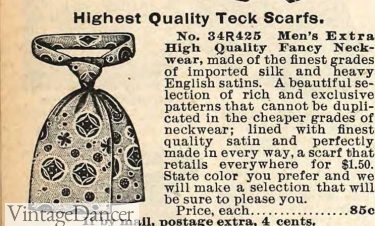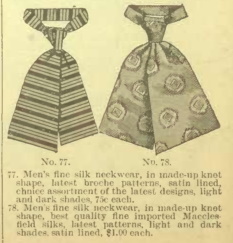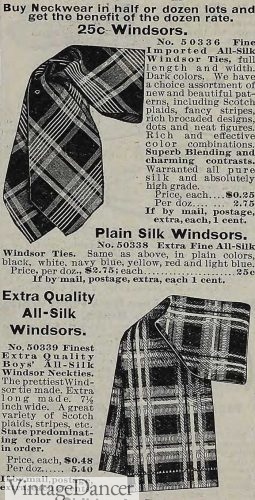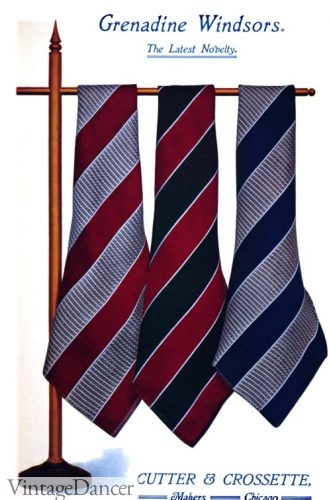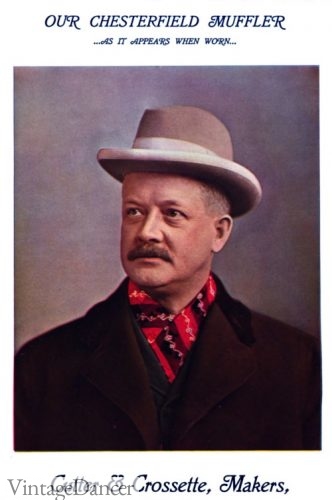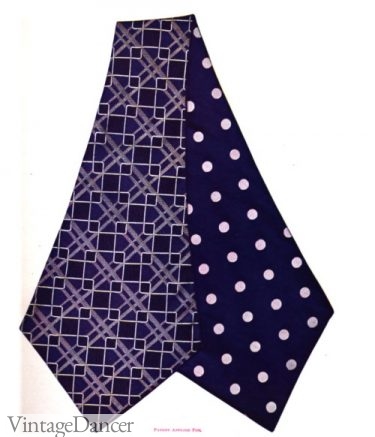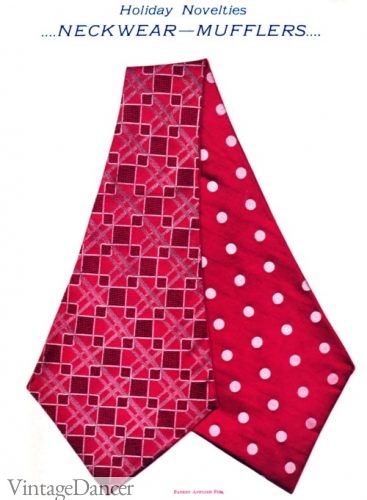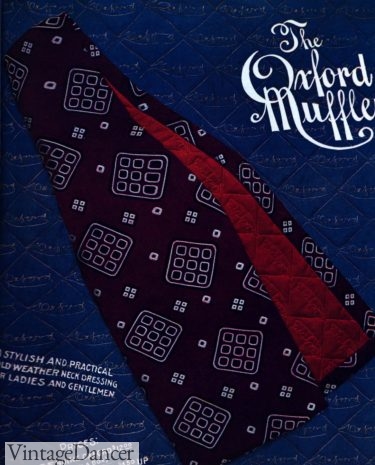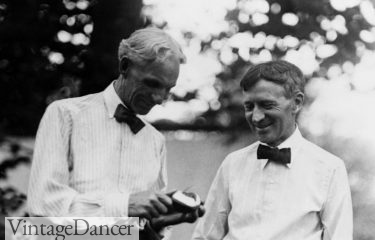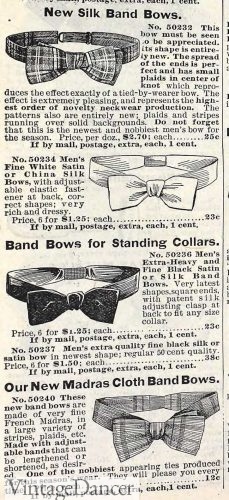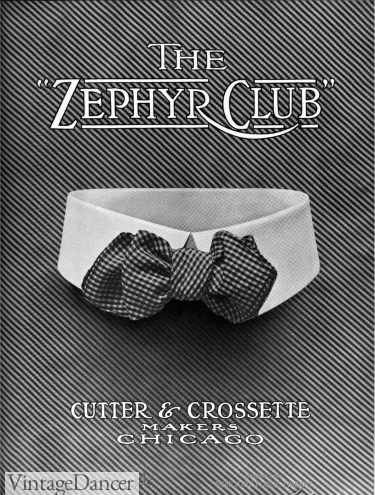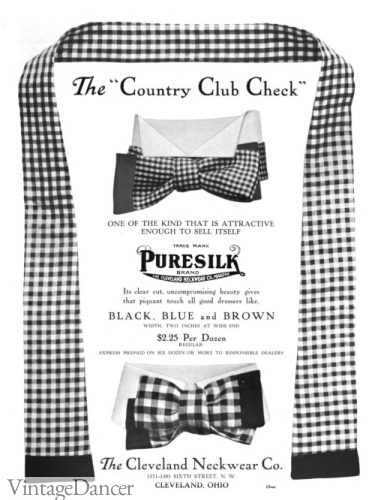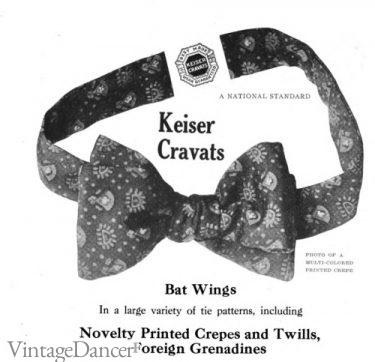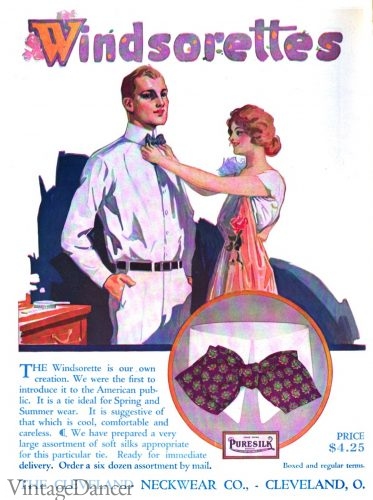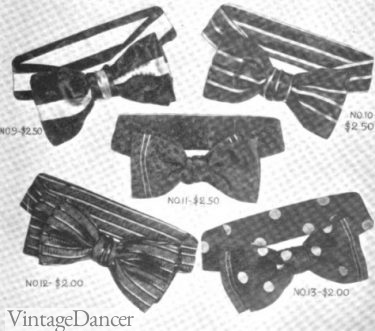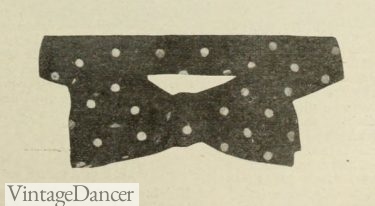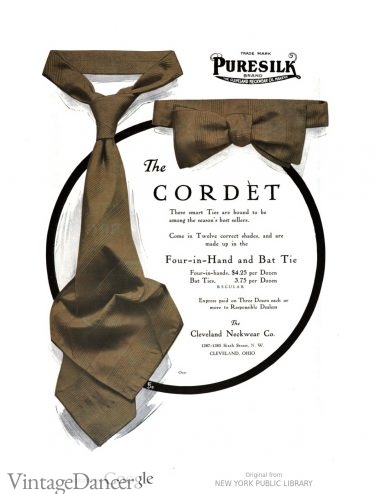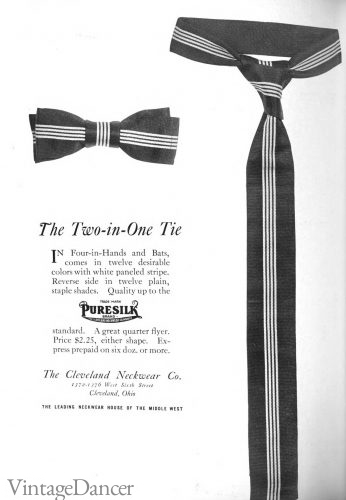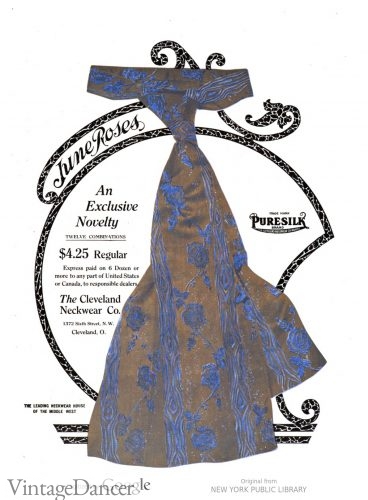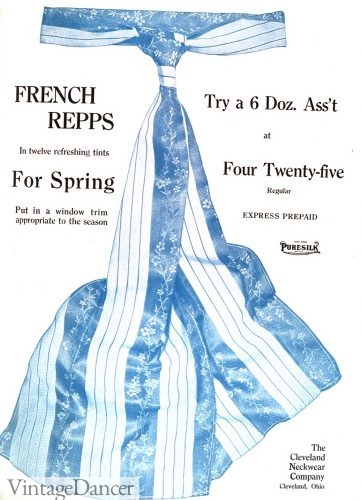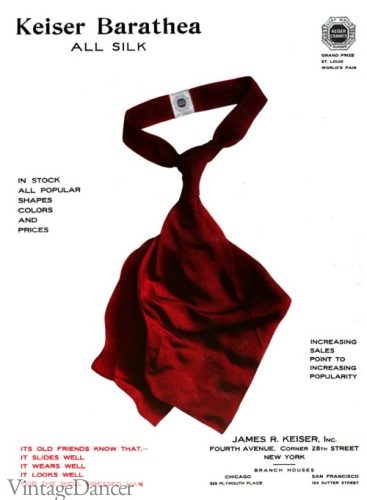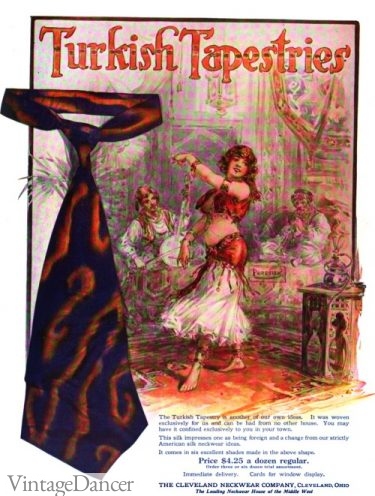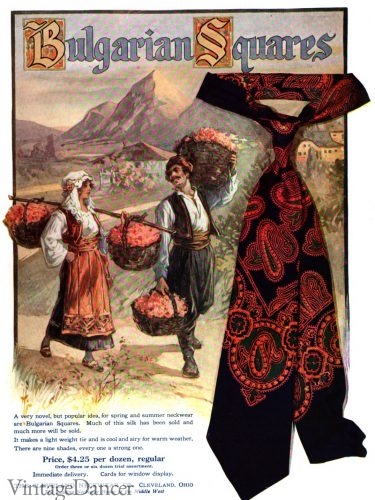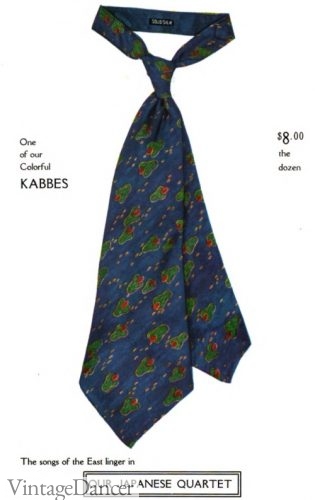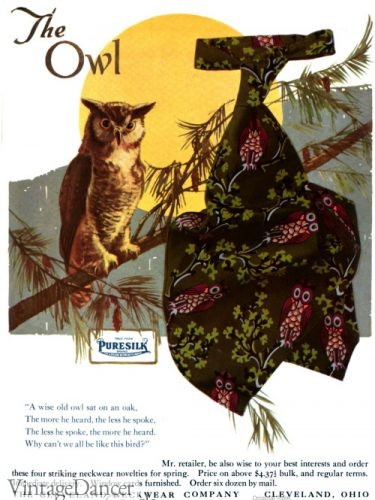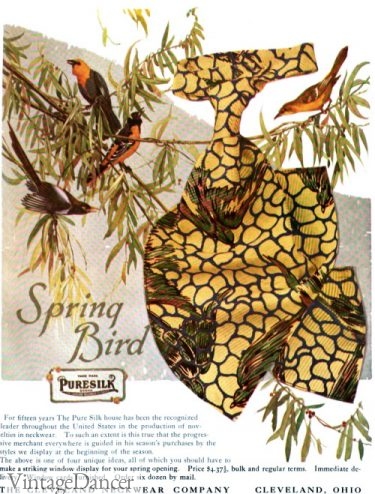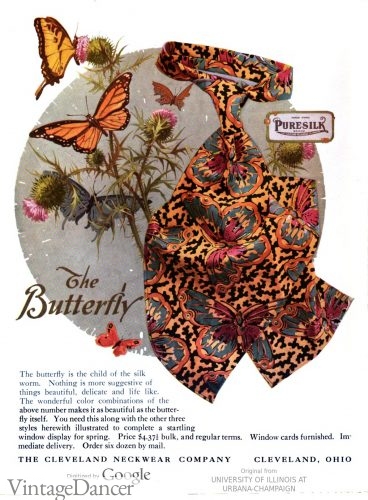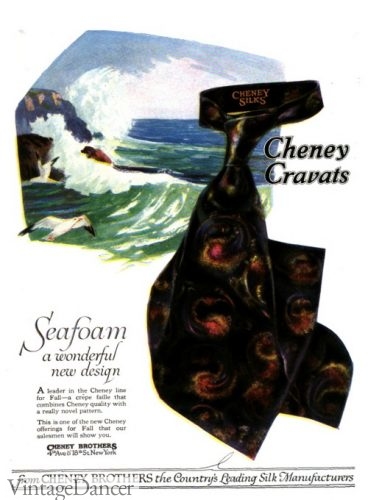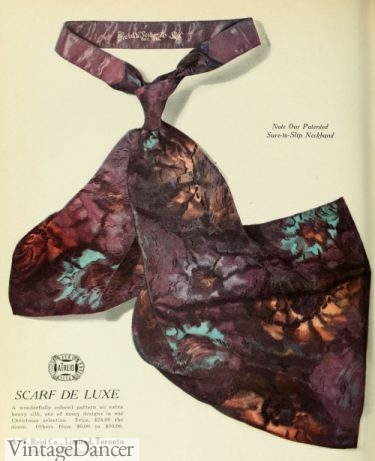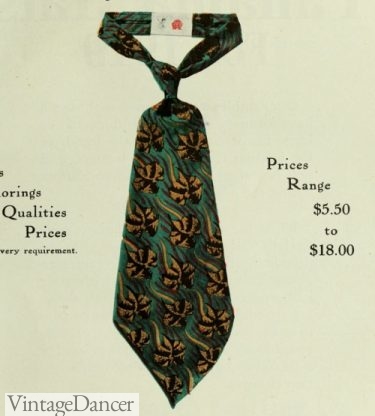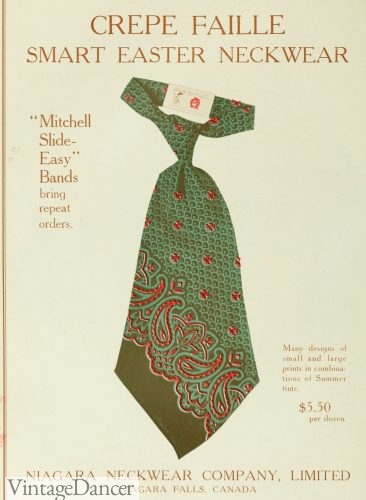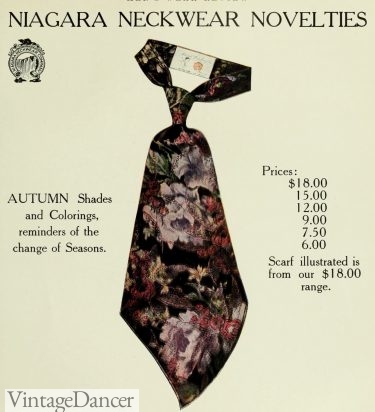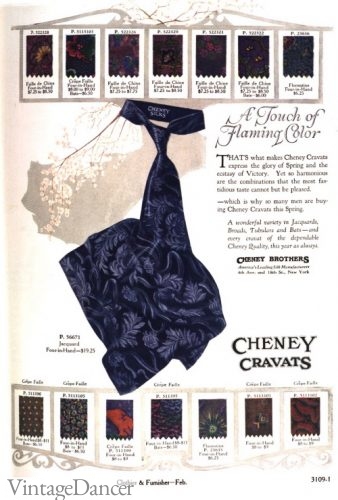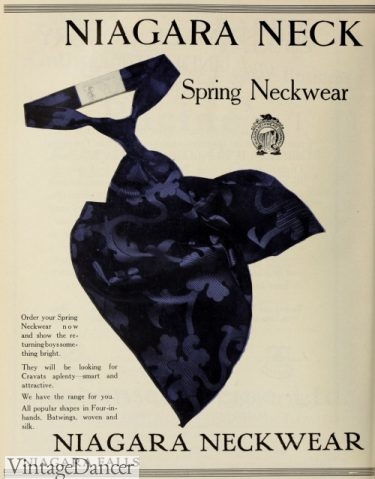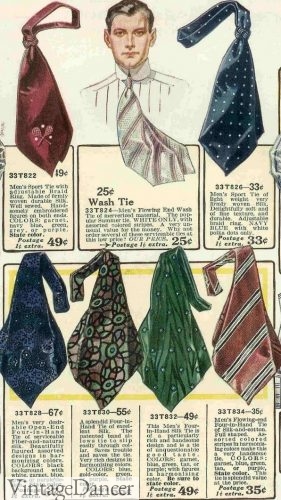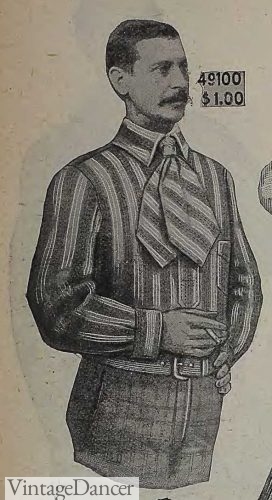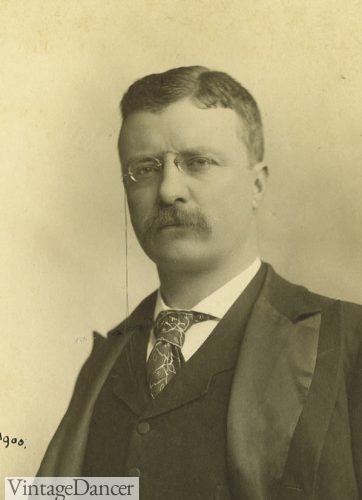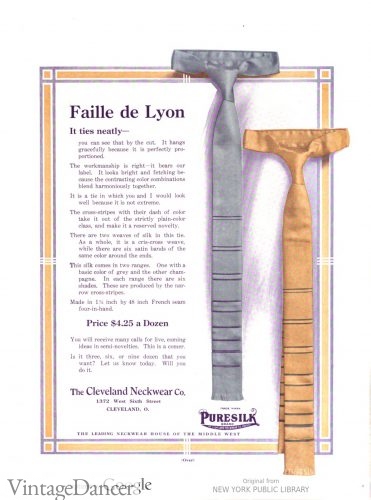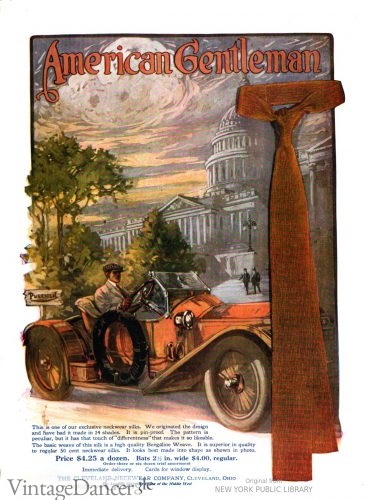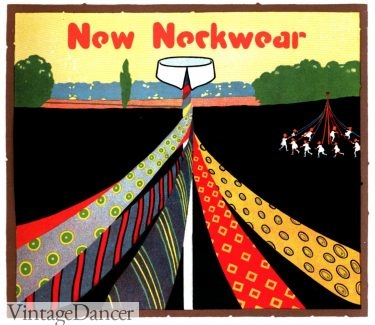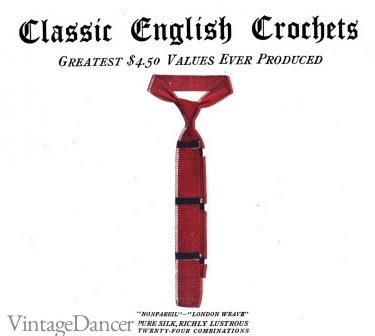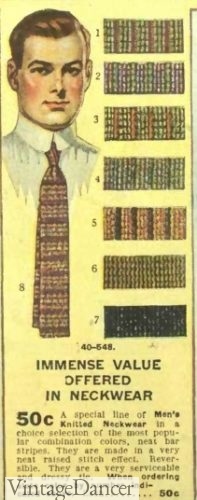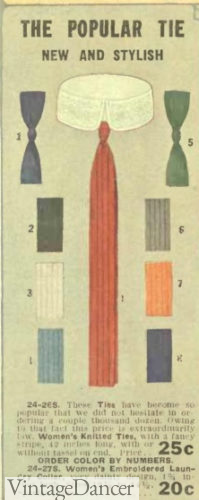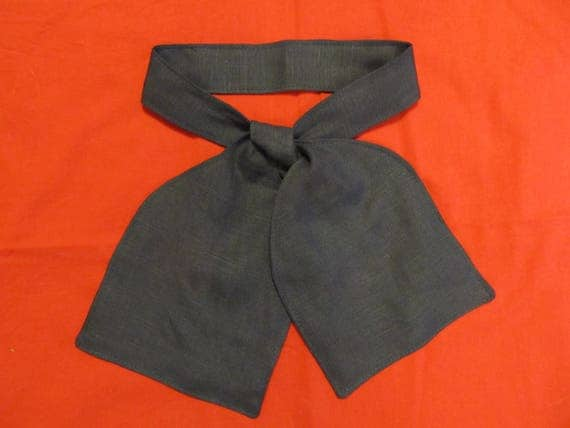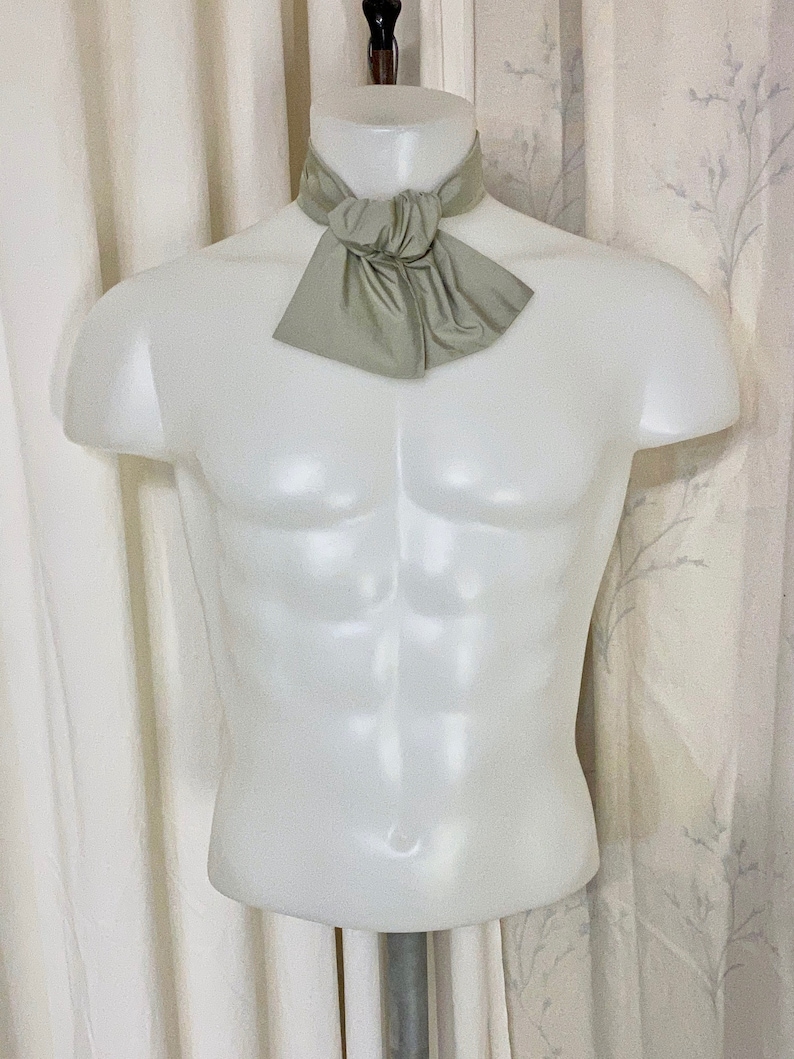Like the variation in Edwardian men’s dress shirts and collar styles, there was an extensive range of neckwear to pair with shirts. Wide and skinny, soft and stiff, long ties, short ties, and bow ties in almost any color and pattern were made. Choosing a necktie was entirely up to the gentleman’s taste, limited only by what fit with his shirt collar.
In the 1900s, the scarf-tie type of neckwear continued to be worn with bright colors. They were very wide at the body, but the knot remained small enough to fit between the edges of high stand collars. The newest invention was the four-in-hand necktie (the same we wear today) which had a thin, tight knot and longer tipped stands.
By the 1910s, everyone was wearing the new four-in-hand style in very wide, moderately wide, and narrow widths. Colors were still very bold and patterns were works of art. After World War I, the skinny tie — especially in knit tie — was the trendiest with young men who were tired of the “old man’s necktie.”
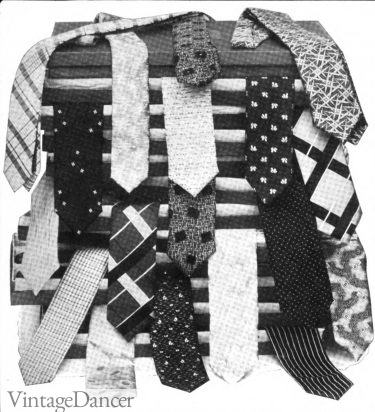
1907 Four-in-Hand Ties
Beside necktie shapes, there were also a plethora of ways to tie a necktie. The knots were often very complicated, requiring the help of a man servant to tie them. The solution for many non-wealthy men was to buy a pre-tied neck tie that clipped around the collar on the backside. These were laughed at in Europe, but American men bought millions of them.
Continuing on, we will review the styles of men’s Edwardian neckwear (1900s neckwear and 1910s neckwear).
Men’s Ties in the 1900s – Edwardian Era
Puff Tie
At the turn of the century, many Victorian era neckties remained common. The Puff tie had a narrow neckband with a rectangular piece of fabric wrapped, knotted, and crossed X-wise in front. The knot was pinned about 2 inches down to keep the two pieces together, and the long flaps were worn tucked under a suit vest to form an overall neat appearance. Puffs could be “imperial” sized with extra wide flaps, or regular with a width of about 3-1/12 inches.
- 1900 blue Squares Puff Tie
- 1900 “Wales” Puff Tie
Teck Scarf Tie
An updated version of the puff tie was called a Teck Scarf tie (named after the Duke of Teck). Instead of a tie knot, it was a small four-in-hand knot with wide rectangular flaps, a bit shorter than the puff tie. As the decade wore on and the Teck tie became more popular, the flaps narrowed, elongated, and developed points — like a typical four-in-hand necktie.
There were two types of Tech Scarf ties: the shield and the band. The Shield bow had two projections of stiff material, such as celluloid, to clip behind the shirt collar. The band style was slipped on overhead and the knot tightened around or under the collar.
- 1900 Teck Scarf Tie
- 1900 Teck Scarf Ties

1905 Teck Tie- Band and Shield Styles
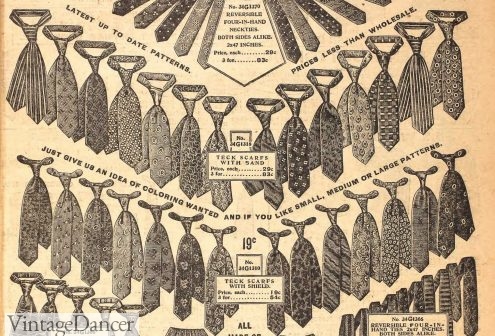
1906 Teck Ties, Now Looking More like Modern Neckties
Cravat Tie
Cravat was another name for necktie, but it was also a specific style of Victorian necktie. It consisted of a wide rectangular piece with point tips, and had 3 pleats at the neck to narrow the fit. It was mostly out of fashion by 1900, but a few old timers kept wearing them.
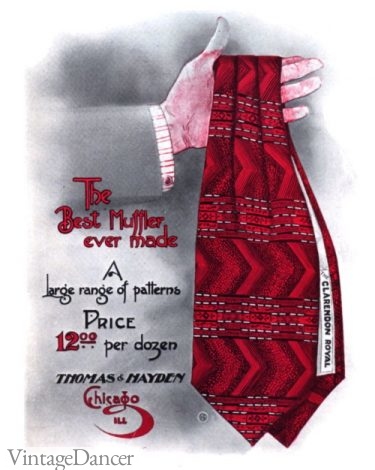
1900 Cravat Tie
Windsor
The Windsor bow tie was a long tie with a slightly narrow neckband and wide point tips. It was tied like a small bow with the ends hanging freely.

- 1900 Plaid Windsor Ties
- 1901 Repro Stripe Windsor Ties
Muffler Tie
The muffler tie was another style of scarf tie, worn in the winter. It was usually reversible or double sided, and was occasionally lined for maximum warmth. The neckband was a little bit smaller than the wide tipped or straight ends. It was designed to be worn over a collar, higher up on the neck, and crossed in front. The ends were then tucked into a suit vest or overcoat.
- 1900 Muffler Tie
- 1900 Purple Muffler – Geo and Polka Dot Prints
- 1900 Red Muffler Tie with Polka Dot Back
- 1900 Purple and Red Muffler Tie
Bow Ties
The pointed end batwing bow tie and butterfly bow tie continued to be worn in the 1900s. There was a brief trend for the rounded end bow tie, but it looked wrong in the eyes of editorialists. Still, there were hardly any limits on bow tie styles in the Edwardian era. Both silk and cotton were formed into bow ties in solid, but usually patterned, bows. Plaid, gingham check, narrow stripes, and polka dots were especially common with casual outfits. Macclesfield ties (small repeating patterns) as well as solid black were favored in professional settings. White was worn in the evenings with formal attire.
- Harvey Firestone (1868-1938) standing with Henry Ford, Both in Bowties
- 1900 Silk Bow Ties
- 1906 Check Bow Tie with Diamond Ends
- 1908 Check Bow Tie for Casual “Country” Use
- 1913 Bat Wing Bow Tie
- 1916 Large Diamond-End Tie
- 1918 Stripe and Dots Bow Ties
- 1919 Polka Dot Bow Tie
- 1908 Men’s Four-in-Hand Tie and Bow Tie
- 1910 Men’s Stripe Four-in-Hand Tie or Bow Tie
The Windsor bow tie was one unique tie that was a cross between necktie and a bow tie. The long, thin fabric was tied up in a small bow at the collar with large flaps hanging down. It was more popular with boys than men. Boys’ neckties were usually attached to an elastic neckband.
- 1901 Repro Stripe Windsor Ties
- 1900 Plaid Windsor Ties

1909 Windsor Bow Tie
1910s Men’s Ties
Four-in-hand Tie – Regular Tie
The four-in-hand tie, named for the type of knot, expanded to a 4-1/4 inch width for most of the two decades. It was, by far, the newest and most practical tie a man could wear — and it remains the type of tie worn today.

1900 Silk Scarf Tie – Four-in-Hand Knot
In 1910, the new Father’s Day holiday was marked with a new tradition of giving dads a gift set, including a four-in-hand tie. Neckties experimented with prints and colors, creating novelty patterns inspired by nature, art, and exotic travel.
You may notice the fly away illustration showing how the ties were constructed with a wide rectangular piece of fabric folded three or four times. In this way, the tie body appeared to be scarf like. When not tucked behind a vest, the ties tended to take flight in the wind. Men would tuck the loose end into his shirt between buttons to keep it out of his face.
- 1909 Print Tie
- 1910 French Repp Stripes Tie
- 1914 Plain Burgundy Tie
- 1913 Turkish Tie
- 1913 Bulgarian Tie
- 1917 Japanese Tie
- 1917 Owl Tie
- 1917 Bird Tie
- 1917 Butterfly Tie
- 1918 Seafoam Tie
- 1918 floral Tie
- 1918 Green and Gold Tie
- 1918 Paisley Tie
- 1918 Floral Painted Tie
- 1919 Cravat Tie
- 1919 Blue Damask Tie
- 1917 Wide Ties
Imperial Tie
At the turn of the century, an extra large four-in-hand tie with the width of 8 inches across was given the name Imperial tie. It needed to be worn with a spread collar to accommodate the wide knot. It was not as common in America as it was in Europe, but a few prominent men wore them with frock coats and formal morning suits.
- 1900 Wide Imperial Stripe Tie to Match the Shirt
- 1900 Theodore Roosevelt Wears a Wide Tie – Likely an Imperial
Four-in-hand Ties / Narrow- Knit Ties
A narrow four-in-hand tie paired best with the newer sack suit. They flared out onto to about 2-1/4 inches at the widest tip, but could be as narrow as 1-3/4 inches or as wide as 2-3/4 inches. Both pointed tips and squared ends were offered, the latter being trendy with college kids. Silk ties with narrow stripes or all-over small repeating patterns helped to make these thin ties stand out. Bright solid colors such as red were especially trendy with casual white summer clothes.
The knit or crochet tie, also called at tubular tie, was a trendy version of the narrow four-in-hand tie. Horizontal stripes were the most common patterns, otherwise solid knit ties were welcome. A few college kids even experimented with leather ties.
- 1912 Narrow Stripe Silk Ties
- 1913 Narrow Tie
- 1917 Novelty Skinny Ties
- 1911 Stripe Knit Tie
- 1916 Knit Narrow Tie
- 1918 Skinny Knit Ties
Read More
- Men’s Neckties in the 1920s
- A History of Men’s Neckties, 1920s-1970s
- 1900s-1910s Men’s Edwardian Shirt Styles
- A History of Men’s 20th Century Jewelry
- Edwardian Men’s Formalwear Guide
Edwardian Neckties Today
The easiest Edwardian necktie to buy today would be a regular men’s necktie in a pattern that fits the period. Avoid geometrics, wide stripes, or modern colors. Choose natural prints, soft abstracts, and traditional colors. Most of the time, you’re best choosing a pattern over a solid color.
Bow ties too are easy to find in stores. Look for full, wide, butterfly ties instead of narrow bow ties.
You can get more of a unique period look if you go for scarf tie, puff tie, or very wide four-in-hand tie. These reproduction neckties and modern neckties will get you started:
Debbie Sessions has been teaching fashion history and helping people dress for vintage themed events since 2009. She has turned a hobby into VintageDancer.com with hundreds of well researched articles and hand picked links to vintage inspired clothing online. She aims to make dressing accurately (or not) an affordable option for all. Oh, and she dances too.
